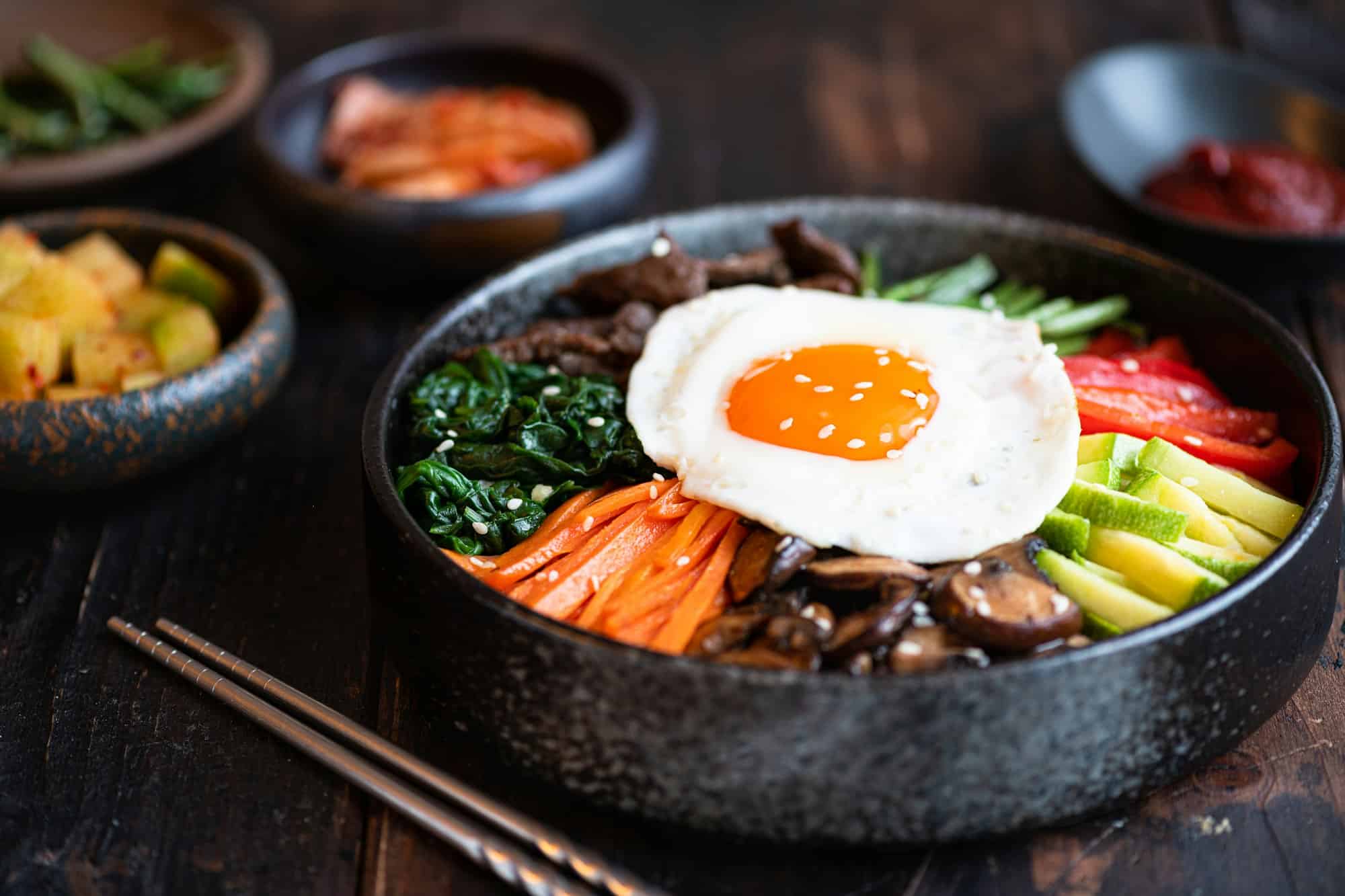Embrace the culinary delights of Korean cuisine with the classic dish, bibimbap. This dish is a medley of flavors that offers a balance of sweet, sour, salty, and spicy. A vegan bibimbap calls for a variety of fresh vegetables, flavorful sauces, and tofu as a protein substitute, all served over a bed of steamed rice. The hero of this dish, however, is the gochujang sauce that adds a distinctive depth of flavor to this Korean rice bowl.
Gochujang is a Korean red chili paste that imparts a sweet heat to dishes, while sesame oil adds a mild nutty flavor. Learning to make bibimbap at home not only leads you to a journey of exploring international cuisines, but also a healthier diet with a balance of proteins, carbs, and a rainbow of vegetables.
Cela peut vous intéresser : Can You Create a Gourmet Spanish Escalivada with Smoky Vegetables and Fresh Anchovies?
Let us break down the process into easy-to-follow steps.
Gathering Your Ingredients
Before embarking on the journey of creating a bibimbap, you must first assemble all your ingredients. For your bibimbap, you will need rice, tofu, an assortment of vegetables like spinach, sesame oil, and of course, gochujang for that distinct flavor.
Dans le meme genre : What Are the Steps for an Authentic Japanese Katsu Curry with Panko-Crusted Chicken?
Bibimbap is a versatile dish, and you can customize your vegetable selection based on seasonal availability or personal preference. The traditional Korean bibimbap includes julienned carrots, bean sprouts, shiitake mushrooms, and spinach. The addition of tofu offers a vegan-friendly protein source that is both healthy and filling.
The Art of Preparing Bibimbap
The first step in the preparation of bibimbap is to cook the rice. A good bibimbap starts with perfectly cooked rice. Rinse the rice under cold water until the water runs clear. This helps to remove the excess starch and makes the rice fluffier. Cook the rice according to the instructions on the package.
While your rice is cooking, you can start to prepare your vegetables. The vegetables in bibimbap are typically lightly sautéed or steamed. Start by washing and then julienning your vegetables. The vegetables should retain their crunch, so don’t overcook them. Sauté each type of vegetable separately in a bit of sesame oil for a few minutes, and then set aside.
Next, prepare the tofu. Cut the tofu into small cubes and fry it in a pan with a little sesame oil until it’s golden brown on all sides. Be careful not to overcook the tofu, you want it to be crispy on the outside but still soft and tender on the inside.
Creating the Flavor-Packed Gochujang Sauce
The gochujang sauce will be the flavor backbone of your bibimbap. Start by mixing the gochujang paste with soy sauce, rice vinegar, sesame oil, and a bit of water. Stir until well combined. You may adjust the flavor to your liking, adding more gochujang paste for a spicier sauce, or more water for a milder one.
This sauce can be made ahead of time and stored in an airtight container in the refrigerator. It will stay fresh for about a week, and the flavors will intensify over time, creating a more robust and flavorful sauce.
Assembling Your Bibimbap
Now that all your components are ready, it’s time to assemble your bibimbap. Start by placing a scoop of warm rice at the bottom of a bowl. Then, arrange the sautéed vegetables and fried tofu on top of the rice.
Now comes the fun part – drizzling the gochujang sauce over the top. Be generous with your sauce application, as it’s the key to elevating your bibimbap to the next level of flavor. Finally, sprinkle some sesame seeds for an extra crunch and a touch of nutty flavor.
Enjoying Your Bibimbap
Enjoying bibimbap is as much about the experience as it is about the flavors. Traditionally, bibimbap is mixed together before eating, allowing the flavors to meld together. So don’t be shy, grab your chopsticks and mix away! The mixture of the fresh, crunchy vegetables, the soft and flavorful tofu, the warm, fluffy rice, and the spicy, tangy gochujang sauce create a flavor-packed experience that is truly unforgettable.
Learning how to make bibimbap at home is a rewarding endeavor. It’s a dish that is both nourishing and flavorful, and one that you can customize to your liking. Whether you’re a fan of spicy foods or prefer your dishes milder, bibimbap has something for everyone. Happy cooking!
How to Perfect Your Bibimbap Sauce
No bibimbap recipe is complete without a perfect bibimbap sauce. This sauce is where the real magic of this dish lies, and it’s what makes every bite delightful and unique.
To create an authentic Korean bibimbap sauce, you should start by sourcing high-quality gochujang. This fermented red chili paste is the heart of the sauce and gives it a distinctive sweet-spicy taste.
Mix two tablespoons of gochujang with one tablespoon each of soy sauce, rice vinegar, and sesame oil. Add a teaspoon of toasted sesame seeds, minced garlic, and a teaspoon of sugar for a hint of sweetness. If you prefer a thinner consistency, feel free to add a little water. Make sure to taste your sauce and adjust the flavors accordingly. Once you have achieved the desired flavor, set it aside for later.
Remember that the key to a good bibimbap sauce is balance. You want a mix of heat from the gochujang, savory depth from the soy sauce, tanginess from the rice vinegar, and a rich, nutty flavor from the sesame oil. The toasted sesame seeds add a wonderful crunch, while the minced garlic adds a burst of flavor.
The Importance of Freshness and Texture in Your Bibimbap
A flavorful bibimbap recipe is all about the freshness and texture of the ingredients. The base of the dish is short-grain rice, which should be cooked until it’s tender and slightly sticky. This type of rice is ideal as it soaks up the bibimbap sauce and holds the dish together.
On top of the rice, arrange your sautéed or stir-fried vegetables and tofu. The traditional mix of vegetables in a Korean bibimbap includes bean sprouts, julienned carrots, spinach, and shiitake mushrooms. However, feel free to experiment with different types of vegetables. The key is to ensure they are fresh and cooked to retain a bit of crunch.
Meanwhile, the tofu should be cut into cubes and pan-fried until golden brown. Tofu is a great source of protein and makes this dish vegan-friendly. When cooked correctly, it should be crispy on the outside and soft on the inside.
Conclusion: The Joy of Making and Eating Bibimbap
Making bibimbap at home can be a fun and rewarding experience. From preparing your ingredients and crafting the bibimbap sauce to arranging the dish and finally, the joy of eating it – every step is a culinary adventure.
This Korean rice bowl is more than just a dish, it’s a feast for the senses. The vibrant colors of the vegetables, the smell of the sesame oil, the heat from the gochujang sauce, and the textural contrast between the soft rice, firm tofu, and crunchy vegetables all contribute to the overall dining experience.
What’s more, bibimbap is a versatile and flexible dish that can be easily customized to suit your dietary needs or taste preferences. Whether you’re vegan, gluten-free, or just a food lover trying to explore international cuisines, this dish is worth trying.
So why not try making bibimbap today? Follow this guide, use the freshest ingredients, learn to perfect your bibimbap sauce, and enjoy a healthy, nutritious meal that is packed with flavor. Happy cooking!






